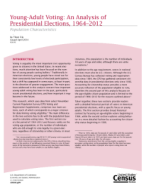
An official website of the United States government
Here’s how you know
Official websites use .gov
A .gov website belongs to an official government organization in the United States.
Secure .gov websites use HTTPS
A lock (
) or https:// means you’ve safely connected to the .gov website. Share sensitive information only on official, secure websites.
-
//
- Census.gov /
- Library /
- Publications /
- Young-Adult Voting: An Analysis of Presidential Elections, 1964-2012
Young-Adult Voting: An Analysis of Presidential Elections, 1964-2012
Young-Adult Voting: An Analysis of Presidential Elections, 1964-2012
Introduction
Voting is arguably the most important civic opportunity given to citizens in the United States. In recent elections, much attention has been focused on the number of young people casting ballots. Traditionally in American elections, young people have stood out for their consistently low levels of electoral participation, but a shift has appeared in some years, at least in part, in the direction of greater engagement. The main questions addressed in this analysis concern how important young-adult voting has been in the past, particularly recent presidential elections, and how important it may become in the future.
This research, which uses data from select November Current Population Survey (CPS) Voting and Registration Supplements, comprises two main sections, each of which corresponds to a major criterion for determining voting eligibility. The main difference in the two sections has to do with the population base used to calculate voting rates. The first section covers the period of 1964–2012 and focuses solely on the voting-age population, or the number of individuals who are old enough to vote legally in a given election, regardless of citizenship or other criteria. In most instances, this population is the number of individuals 18 years of age and older, although there are some exceptions.
In addition to the age requirement, voters in national elections must also be U.S. citizens. Although the U.S. Census Bureau has collected voting and registration data since 1964, the CPS has gathered consistent citizenship data in presidential elections only since 1996. Accounting for citizenship status provides a more accurate reflection of the population eligible to vote, therefore the second part of this analysis focuses on the age-eligible citizen population and is limited to the period of 1996–2012 for the reasons outlined above.
Taken together, these two sections provide readers with a detailed historical portrait of voters in American presidential elections, with a specific focus on young adults. The first section provides broad historical context by focusing on age-eligible voters beginning in 1964, while the second section explores voting behavior in a more detailed fashion by accounting for citizenship status beginning in 1996.
Others in Series
Publication
Publication
Publication
Share
Some content on this site is available in several different electronic formats. Some of the files may require a plug-in or additional software to view.
 Yes
Yes
 No
NoComments or suggestions?


Top

